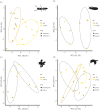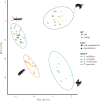Oxidative stress and senescence in social insects: a significant but inconsistent link?
- PMID: 33678022
- PMCID: PMC7938172
- DOI: 10.1098/rstb.2019.0732
Oxidative stress and senescence in social insects: a significant but inconsistent link?
Abstract
The life-prolonging effects of antioxidants have long entered popular culture, but the scientific community still debates whether free radicals and the resulting oxidative stress negatively affect longevity. Social insects are intriguing models for analysing the relationship between oxidative stress and senescence because life histories differ vastly between long-lived reproductives and the genetically similar but short-lived workers. Here, we present the results of an experiment on the accumulation of oxidative damage to proteins, and a comparative analysis of the expression of 20 selected genes commonly involved in managing oxidative damage, across four species of social insects: a termite, two bees and an ant. Although the source of analysed tissue varied across the four species, our results suggest that oxidative stress is a significant factor in senescence and that its manifestation and antioxidant defenses differ among species, making it difficult to find general patterns. More detailed and controlled investigations on why responses to oxidative stress may differ across social species may lead to a better understanding of the relations between oxidative stress, antioxidants, social life history and senescence. This article is part of the theme issue 'Ageing and sociality: why, when and how does sociality change ageing patterns?'
Keywords: ageing; antioxidant genes; longevity; protein oxidation; social insects; transcriptomes.
Figures



Similar articles
-
The plasticity of lifespan in social insects.Philos Trans R Soc Lond B Biol Sci. 2021 Apr 26;376(1823):20190734. doi: 10.1098/rstb.2019.0734. Epub 2021 Mar 8. Philos Trans R Soc Lond B Biol Sci. 2021. PMID: 33678025 Free PMC article. Review.
-
Comparative transcriptomic analysis of the mechanisms underpinning ageing and fecundity in social insects.Philos Trans R Soc Lond B Biol Sci. 2021 Apr 26;376(1823):20190728. doi: 10.1098/rstb.2019.0728. Epub 2021 Mar 8. Philos Trans R Soc Lond B Biol Sci. 2021. PMID: 33678016 Free PMC article.
-
The effect of environmental stress on ageing in a termite species with low social complexity.Philos Trans R Soc Lond B Biol Sci. 2021 Apr 26;376(1823):20190739. doi: 10.1098/rstb.2019.0739. Epub 2021 Mar 8. Philos Trans R Soc Lond B Biol Sci. 2021. PMID: 33678015 Free PMC article.
-
Why and how do termite kings and queens live so long?Philos Trans R Soc Lond B Biol Sci. 2021 Apr 26;376(1823):20190740. doi: 10.1098/rstb.2019.0740. Epub 2021 Mar 8. Philos Trans R Soc Lond B Biol Sci. 2021. PMID: 33678028 Free PMC article.
-
Demographic mechanisms for the evolution of long life in social insects.Exp Gerontol. 2001 Apr;36(4-6):713-22. doi: 10.1016/s0531-5565(00)00237-0. Exp Gerontol. 2001. PMID: 11295510 Review.
Cited by
-
The plasticity of lifespan in social insects.Philos Trans R Soc Lond B Biol Sci. 2021 Apr 26;376(1823):20190734. doi: 10.1098/rstb.2019.0734. Epub 2021 Mar 8. Philos Trans R Soc Lond B Biol Sci. 2021. PMID: 33678025 Free PMC article. Review.
-
Social isolation shortens lifespan through oxidative stress in ants.Nat Commun. 2023 Sep 27;14(1):5493. doi: 10.1038/s41467-023-41140-w. Nat Commun. 2023. PMID: 37758727 Free PMC article.
-
Leafhopper males compensate for unclear directional cues in vibration-mediated mate localization.Sci Rep. 2023 Jun 1;13(1):8879. doi: 10.1038/s41598-023-35057-z. Sci Rep. 2023. PMID: 37264041 Free PMC article.
-
Extended longevity of termite kings and queens is accompanied by extranuclear localization of telomerase in somatic organs and caste-specific expression of its isoforms.Insect Sci. 2025 Apr;32(2):364-384. doi: 10.1111/1744-7917.13418. Epub 2024 Jul 21. Insect Sci. 2025. PMID: 39034424 Free PMC article.
-
Cockroaches: a potential source of novel bioactive molecule(s) for the benefit of human health.Appl Entomol Zool. 2023;58(1):1-11. doi: 10.1007/s13355-022-00810-9. Epub 2022 Dec 15. Appl Entomol Zool. 2023. PMID: 36536895 Free PMC article. Review.
References
-
- Keller L, Genoud M. 1997. Extraordinary lifespans in ants: a test of evolutionary theories of ageing. Nature 389, 958-960. ( 10.1038/40130) - DOI
-
- Kramer BH, Schaible R. 2013. Colony size explains the lifespan differences between queens and workers in eusocial Hymenoptera. Biol. J. Linnean Soc. 109, 710-724. ( 10.1111/bij.12072) - DOI
-
- Korb J, Thorne B. 2017. Sociality in termites. In Comparative social evolution (eds Rubenstein DR, Abbot P), pp. 124-152. Cambridge, UK: Cambridge University Press.
Publication types
MeSH terms
Substances
Associated data
LinkOut - more resources
Full Text Sources
Other Literature Sources
Medical

